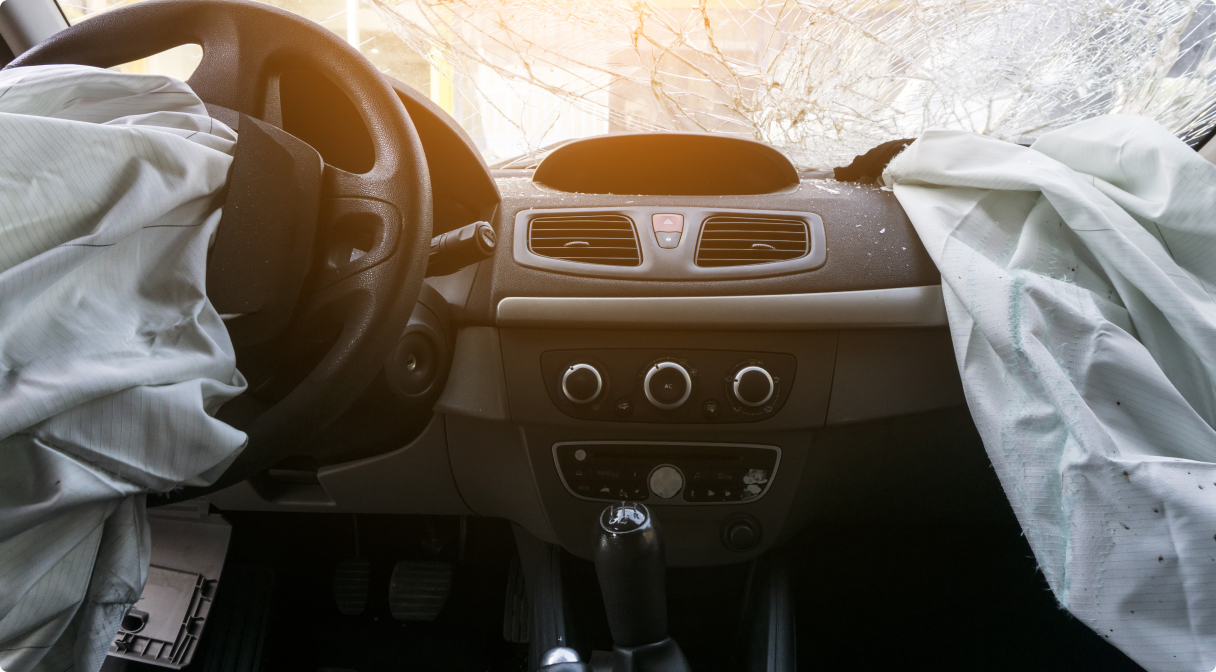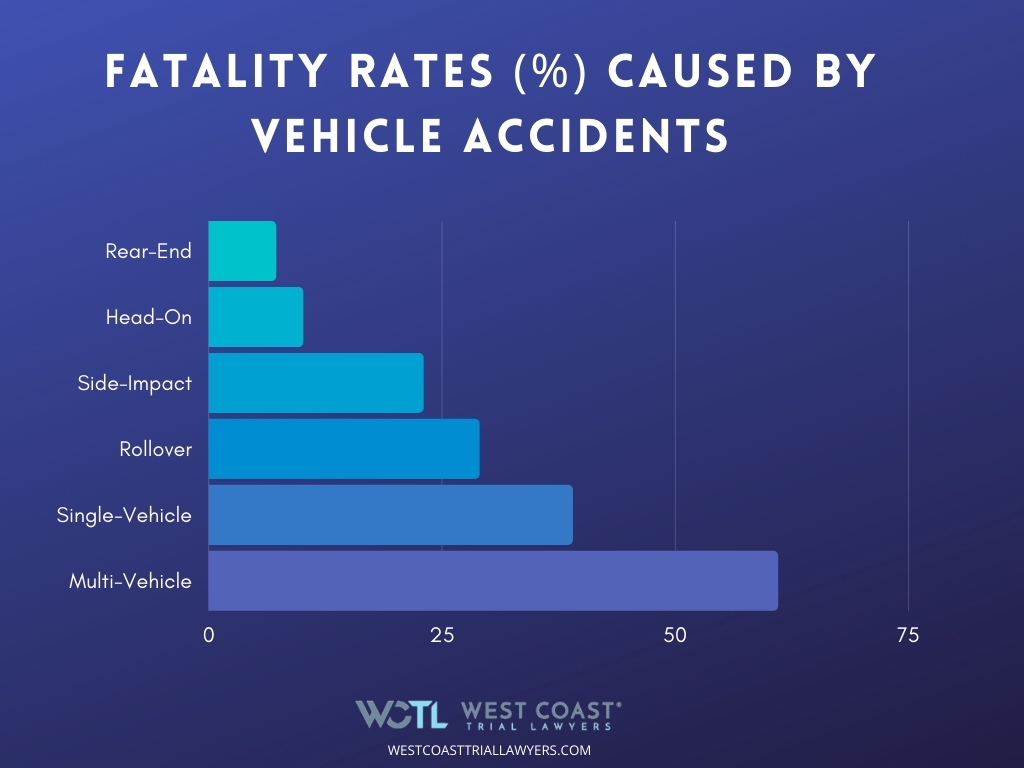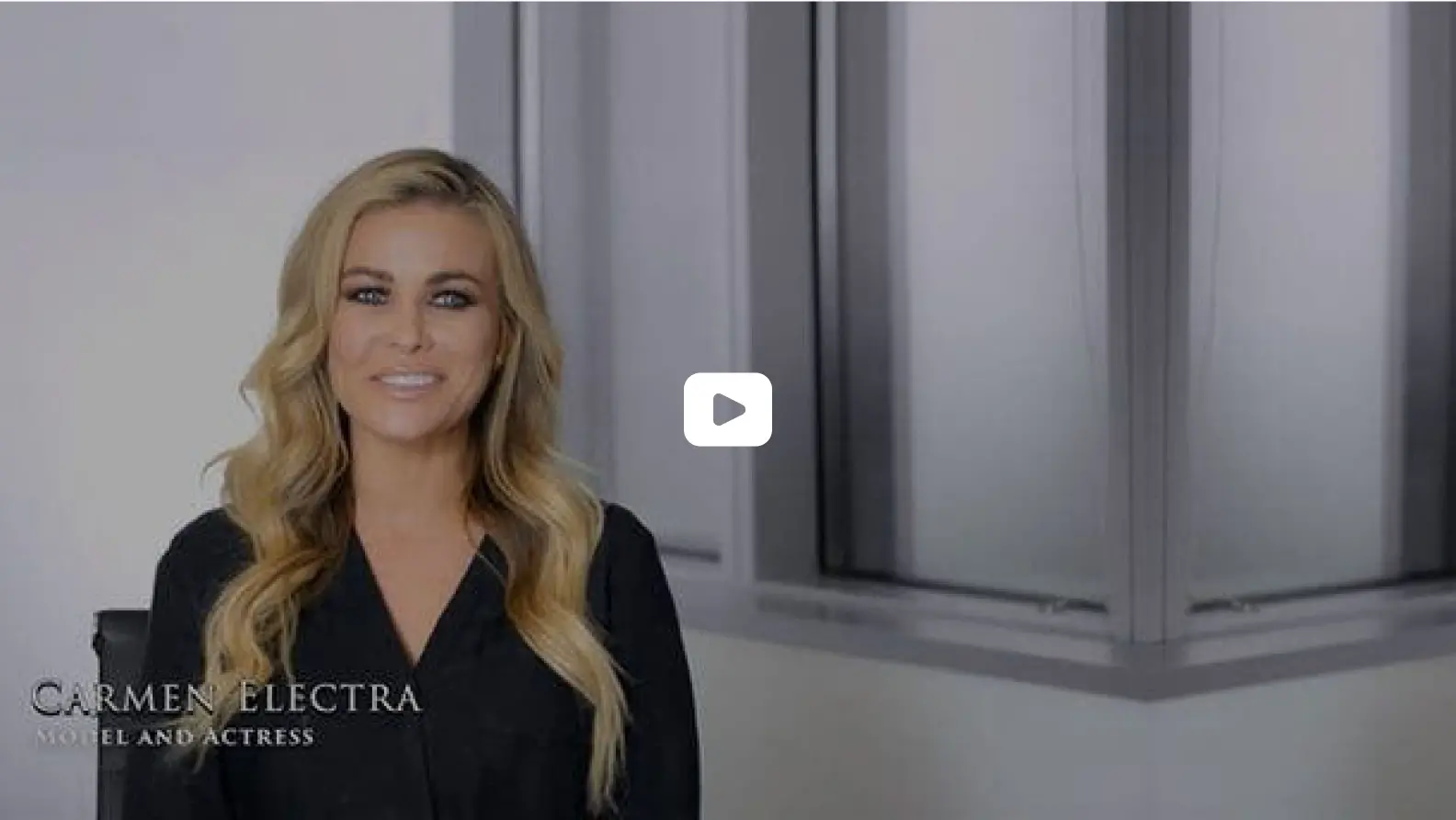
Most Common Types of Serious Car Accidents in California
6 Common Types of Serious Car Accidents That Have Occurred on California Roads
Serious car accidents happen all the time. In fact, millions of Americans are injured every year in car accidents, and thousands more are killed. Those who do survive are often left to deal with various forms of injury, including permanent disabilities such as brain damage and spinal cord injuries. Moreover, some form of negligence on behalf of one or multiple drivers is often the culprit in the majority of all car accidents.
The U.S. Department of Transportation's Fatality Analysis Reporting System (FARS) and the Polk Company's National Vehicle Population Profile reported that passenger vehicle occupant deaths accounted for 63 percent of 36,560 fatal motor vehicle accidents in 2018.
Every auto accident has the potential to result in injuries for the driver and their passenger(s). Those who are involved in a vehicle collision often suffer physical and/or psychological injuries that may require medical attention.
Property damage may also occur. It does not seem fair for a victim of an accident to deal with all of these costs, while the negligent driver gets away with their reckless behavior. This is primarily why it is important for victim’s to file a lawsuit against the individual at-fault so they can receive compensatory damages.
Victims of a car accident are welcomed to contact our experienced car accident attorneys at West Coast Trial Lawyers. We will strengthen your claim and negotiate with insurance companies to get you a fair settlement offer.
To schedule a free consultation, please contact our 24/7 legal team by calling 213-927-3700 or filling out our quick contact form.

Rear-End Collisions
A rear-end collision occurs when one vehicle hits the back of another. Some common factors that lead to a rear-end collision include driver distraction, tailgating, panic stops, and bad road conditions.
In 2017, rear-end collisions were the third most common type of collisions, with 7.2 percent of these being fatal. Though rarely deadly, they can still cause serious injuries and significant loss of property.
Among the most common types of injuries from a rear-end collision are back and neck injuries. However, symptoms may take days or weeks to appear and/or cause any adverse effects.
In this type of collision, there is a chance the trailing driver will share partial liability, given that all drivers have a duty to maintain a safe distance between themselves and the car in front of them. There are even certain circumstances in which the driver who was hit may be the one held liable for the accident. In such cases, the driver who was hit could actually be found guilty of negligence.
Head-On Collisions
A head-on collision occurs when two vehicles, which are traveling in opposite directions, directly crash into one other. Speed takes a large role in these types of accidents, since it can exacerbate the severity of the crash, the risks of death and injuries, and the vehicle repair costs.
According to 2020 data collected by the Insurance Information Institute (III), head-on collisions were the second most common type of accidents in the country, with 10.2 percent being fatal. Frontal impacts contributed to 58 percent of passenger vehicle occupant deaths. These types of accidents often occur as a result of mechanical failure or a driver’s negligence, such as when a driver ends up on the wrong side of the road, is under the influence of alcohol or drugs, or is distracted.
The impact of a head-on collision is more severe than in other types of accidents, and the accumulated costs of medical care associated with treating subsequent injuries will likely be high. Some of the more devastating injuries that result from a head-on collision include brain trauma, paralysis, broken bones, and disfigurement.
Determining liability in a head-on collision can be challenging. The violent impact could cause both cars to fly in different directions. The aftermath of how the vehicles are positioned may appear completely different compared to where they were when the collision took place. If you were involved in a head-on collision, you must show proof that the negligent driver was at-fault for triggering the accident in order for you to receive compensation for damages.
T-bone Accidents or Side-Impact Collisions
Side-impact collisions — often known as “T-bone crashes” - are one of the most commonly occurring car accidents in the United States, and generally take place when one vehicle is impacted directly on its side at an angle of 90 degrees. These crashes often take place at intersections and parking lots. Some of the most recurring reasons for side-impact collisions are from distracted driving, drunk driving, or failing to yield to oncoming vehicles.
A T-bone collision can be gravely serious and potentially fatal in many cases due to the violent, direct nature of the impact. A car that is struck in a side-impact collision is completely vulnerable to being impacted with brutal force and has literally nothing to protect itself, especially when high speeds are involved. Moreover, an occupant that is seated on the struck side of the vehicle will most likely endure severe injuries compared to a front or rear collision. Side-impact collisions contributed to 23 percent of passenger vehicle occupant deaths in 2019.
The aftermath of these types of accidents tends to be the most devastating. Some of the most common types of injuries include whiplash, head injuries, punctured eardrums, spinal injuries, and internal bleeding.
Negligence often plays a significant role in the majority of all side-impact collisions, and a plaintiff who chooses to bring a personal injury lawsuit against a negligent driver will have to prove that the other driver’s negligence was indeed the direct cause of the accident. In order to do this, a victim’s car accident lawyer must demonstrate that the offending driver violated his or her duty of avoiding risk of harming another driver by a reckless or negligent action.
Rollover Vehicle
A rollover accident is a type of vehicle crash in which a vehicle tips over onto its side or roof. According to Safecar, these types of crashes have a higher fatality rate than other types of vehicle collisions. In 2019, 6,583 passenger vehicle occupants died in a fatal rollover accident. 74 percent of rollovers occurred due to a pre-rollover impact, while 26 percent rolled over without having any impact prior to the accident.
Any type of vehicle can rollover. Taller, narrower vehicles like SUVs, pickups, and vans are far more likely to rollover compared to average cars. These vehicles have a higher center of gravity, which makes them more top-heavy.
As Consumer Reports explains: “Sideways forces that develop when a vehicle rounds a curve shifts the center of gravity to one side, which can have a dramatic effect on the vehicle's balance. The lateral forces increase with speed and also with rapid changes of direction —for example, when a driver makes too sharp a turn one way and then overcorrects the other way. Those transitions can set up a pendulum effect, with larger and larger swings and an eventual loss of control… The vehicle usually has to "trip" on something, such as when it swerves into a curb, pothole, or a soft roadside shoulder.”
The Insurance Institute for Highway Safety (IIHS), reported that the rollover driver-death rate for new, 1 to 3 year old, passenger vehicles decreased from 27 in 2000 to 6 in 2012.The newer SUVs have lower rates compared to newer cars.
Single-Vehicle Collisions
A single-vehicle collision is when one vehicle gets into an accident without involving another driver. This typically happens with distracted drivers that strike an object on the side of the road. Poor road or weather conditions may also contribute to single-vehicle collisions.
Depending on the situation and the speed, this type of car accident can result in a devastating outcome. In 2019, 39 percent of car occupant deaths were caused by single-vehicle crashes, while 61 percent were from multiple-vehicle crashes. Single-vehicle crashes contributed to 56 percent of pickup occupant deaths and 49 percent of SUV occupant deaths.
Multi-Vehicle Collisions
A multi-vehicle collision is an accident involving multiple vehicles, which only increases the risk of serious injury and significant property loss. They typically occur on freeways and are considered as one of the deadliest types of traffic accidents. Higher speeds on freeways make it that much more difficult for drivers to avoid and react. Ironically, they can be made worse by drivers trying to avoid a collision in the first place. Some causes of multi-vehicle collisions include weather conditions, texting while driving, reckless driving, and driving while drowsy.
As aforementioned, 61 percent of car occupant deaths in 2019 occurred in multiple-vehicle crashes. Frontal impacts contributed to 15 driver fatalities per million registered passenger vehicles, whereas side-impacts caused 5 fatalities per million. Multiple-vehicle rear impacts caused 2 fatalities per million.
The most complex issue in cases involving multiple vehicles is identifying the negligent or at-fault driver. Liability will depend on two legal concepts called duty of care and proximate cause. Another important legal consideration in multi-car collisions is the issue of comparative vs. contributory negligence. The state of California abides by the rules of comparative negligence, which means that a claimant involved in an accident may get compensation against the at-fault driver even if the claimant is partly responsible.
Multi-car accidents often result in multiple claims and, therefore, usually become severely contested, drawn out affairs, since there’s no real standardized method for assigning liability in these types of collisions. Therefore, you will probably need to seek out an expert legal team to help you navigate this complex process.
Available Damages After a Car Accident
A car accident victim may be entitled to compensatory damages for:
- Emotional Distress
- Lost Wages
- Medical Bills
- Loss of Consortium
Not all car accidents are the same, and they often involve a multitude of different implications that will make a difference when taking a case to court.
West Coast Trial Lawyers Is Here to Help
If you have sustained injuries as a result of another driver’s carelessness, you have the right to hold that driver responsible. Our skilled car accident attorneys at West Coast Trial Lawyers can help you recover compensation for the losses you have suffered, including medical bills, property damage, lost wages, and pain and suffering.
Contact us today by calling 213-927-3700 or filling out our contact form to schedule a free consultation with our experienced, caring, and compassionate legal team.




